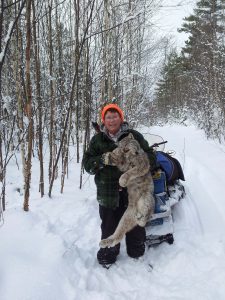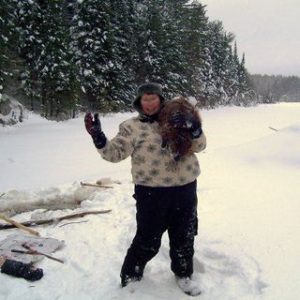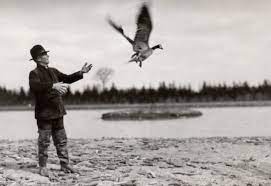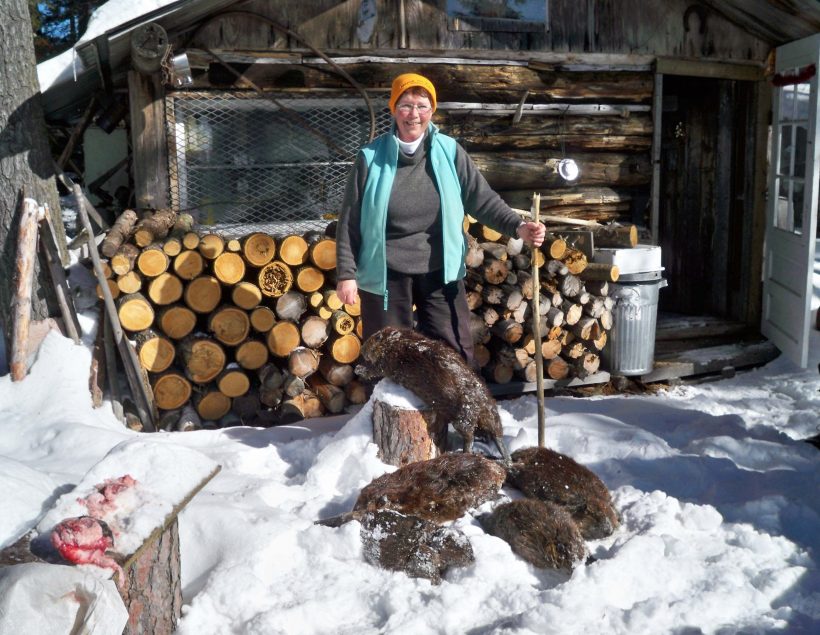A TRAPPING FIRST
Carmen Cotnoir of Spanish, Ontario, was the first woman trapper to be voted President of the Ontario Fur Managers Federation. “I was elected August 28, 2016 at the OFMF Rendezvous convention in Thunder Bay,” she told me. Inspired to trap by her brother in Chalk River she would spend a few days with him on his trapline. He signed her up for the Fur Harvesters, Fur Management and Conservation Course. “I was hesitant but he convinced me I could definitely do the job.”
Following the course, Cotnoir knocked on the door of the oldest trapper in Spanish, Alvin Beckerton and asked if he was willing to take on a helper. “I was not sure what to expect. I was scared he would laugh and tell me to go back to my kitchen.” He didn’t (tell her to go back to the kitchen), took her on and “since that day my life took a new trail…the bush.”
Alvin Beckerton was born in 1925.”We lost Monsieur Beckerton a year ago. He started trapping at a very young age, as boys would in those days,” she said, adding that she hopes to trap as long as he did. She is very grateful to Beckerton. To date (2016) Cotnoir has trapped over 20 years and is starting her 17th year as a registered trapper.
Cotnoir finds being a retired educator has helped her organize her trapping and Presidential duties. She says that she is very fortunate to have a much diversified trapline. Annually she harvests, on average, 50 beaver plus marten, fisher, bobcat, lynx, coyote, wolves, raccoon, mink, weasel, muskrat and otter.
 Cotnoir never over harvests in order to keep the trapline healthy. She also traps nuisance animals. “I am also a Fur Harvester, Fur Management and Conservation Course instructor.” She hopes, as one of her goals as President, that the public will discover today’s trappers vary in age, gender, come from all walks of life, are true conservationists and stewards of the land.
Cotnoir never over harvests in order to keep the trapline healthy. She also traps nuisance animals. “I am also a Fur Harvester, Fur Management and Conservation Course instructor.” She hopes, as one of her goals as President, that the public will discover today’s trappers vary in age, gender, come from all walks of life, are true conservationists and stewards of the land.
Cotnoir’s trapline is north of Spanish and is made up of three sections. She starts the season on her first section with her 4 wheeler transferring to her snowmachine as conditions warrant. Sections two and three are covered by snowmachine. Once the ice is safe for lake travel she accesses the far end of her trapline, usually by mid-January. In short, Carmen traps sections 1 and 2 until the end of January, then moves on to section 3 until the end of February.
From November until the end of January Carmen travels her trapline on Wednesdays and Saturdays. During the other days she is skinning, fleshing and stretching her harvest. In February, since section 3 is a 50 mile commute, Carmen will leave on a Saturday, sleep over in an old log cabin built in the ‘40s, and return the next day. She repeats the schedule on Wednesdays – until the end of February. For 6 days in the spring she traps muskrats (‘rats) on private land on the Spanish River as well as trapping nuisance animals such as beaver, ‘coon and coyote.

How does one manage a trapline and fulfill the duties of the office of President of the OFMF?
“I definitely have to make a schedule, and be versatile. Keeping trapping matters top of the list. Being a retired educator also helps.”
Cotnoir taught for 25 years, graduating from Teacher’s College in Sudbury (1974), teaching French from grade one to post secondary, including the Sault College in Elliot Lake and the new French College Boreal in Elliot Lake until it closed down. She retired in 2000 continuing to supply at Ste Anne primary in Spanish until two years ago.
Beaver are very special to Carmen. Each colony on her trapline is identified with its own name. She only takes two beaver per house thus keeping the families healthy and strong to pass the winter months. “A beaver is not only an animal, it is an ecosystem.” She also takes pains not to overharvest any other fur bearers. “I like to compare my trapline to the carrot patch in the garden. Once the carrots start growing we must pull out the excess carrots to give a chance to the others to grow longer and bigger.”
One message the new President wants to impart is that to-day’s trappers vary in age, gender and come from all walks of life. Years ago a woman’s role was more supportive but with to-day’s tools and technology – such as trap setters and dependable snowmachines – women can do the job. As a matter of interest, of the approximate 5900 OFMF members, 521 are women.
I asked Carmen the indelicate question of age. “I am still 29 years old at heart.”
FYI the next OFMF Rendezvous will be hosted in Carp Ontario during August 25/26, 2017. “Being our 150th you can expect a lot of varied celebrations considering the proximity to Ottawa.”
BIBLICAL BIRDS
Long time readers with longer memory banks will recall past columns devoted to Jack Miner, often referred to as the Father of Conservation, in part for his bird banding initiatives.
I just read an account of duck hunters from Virginia who were pleasantly surprised to discover that a downed drake was banded with what they described as “a piece of jewelry delivered from the sky.” The vast majority of bands on migrating waterfowl are part of the North American bird-banding program which has banded millions of varied species since 1904. Generally, they are numbered.
However, this particular drake’s band had a biblical inscription, originating at the Jack Miner Migratory Bird Foundation in Kingsville, Ontario. I’m sure some readers have been there. Miner founded his bird sanctuary in 1904 for the conservation of Canada geese and other waterfowl. Jack began banding ducks in 1909, geese in 1915 and referred to the biblically banded birds as “missionaries of the sky.”
One anecdotal tale tells of a hunter who was considering taking his own life finding such a message that inspired him to change his mind.

Before passing on in 1944, Jack Miner banded 50,000-plus ducks and 40,000 geese. For more information goto: jackminer.ca.
AND FINALLY… WELCOME WEATHER REPORT
From more than one radio station in this frigid weather: “30% chance of flowers.”
Photos – courtesy Carmen Cotnoir
